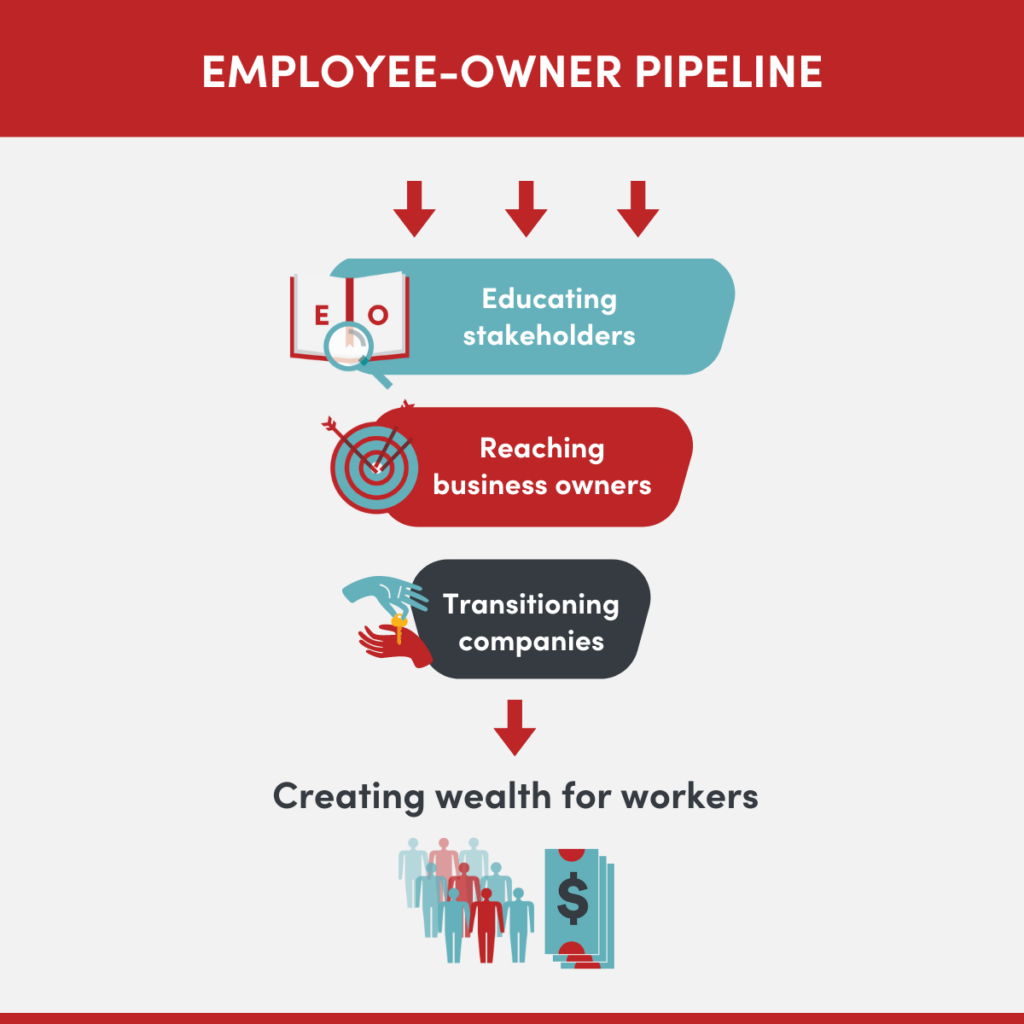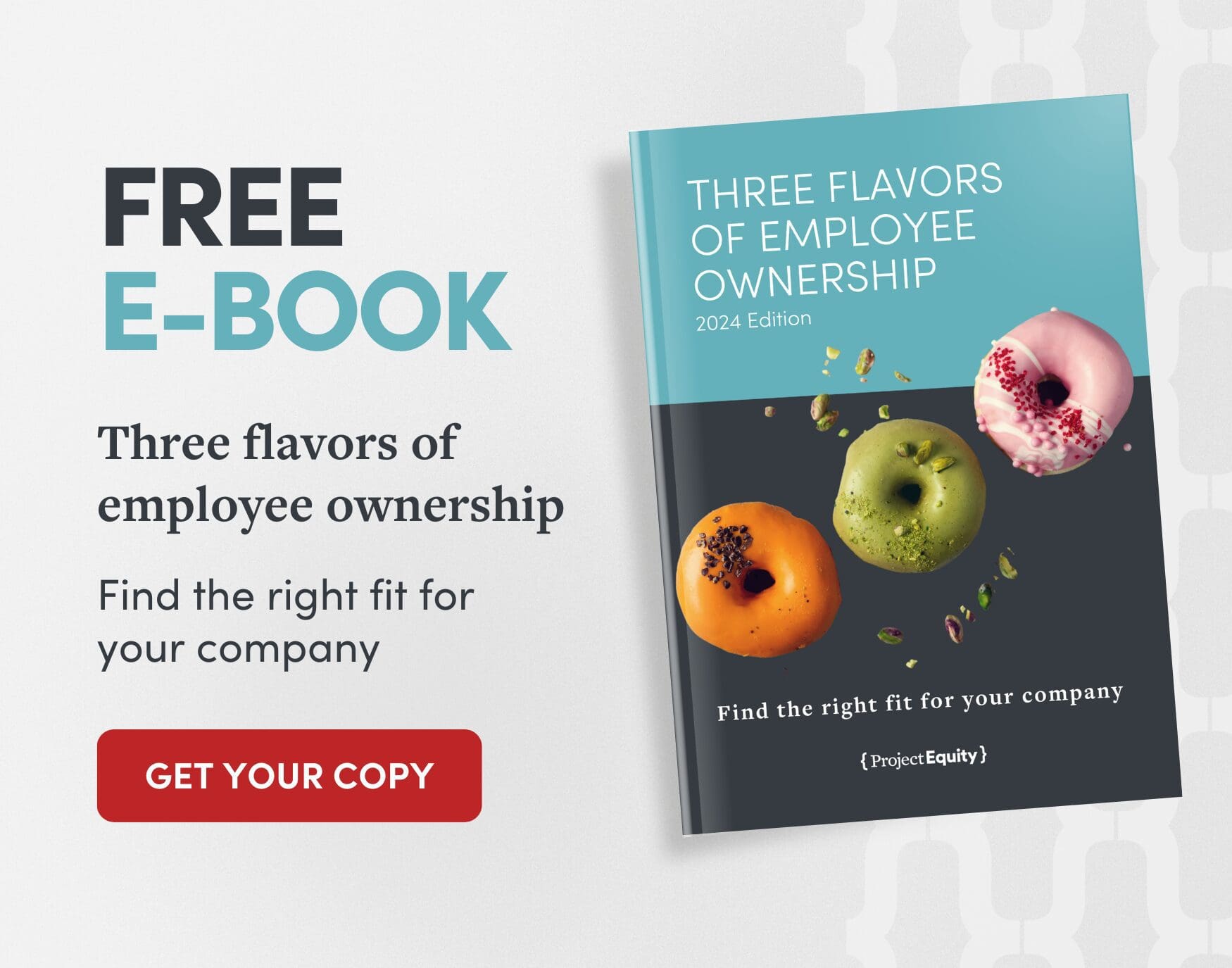The employee ownership pipeline: What we’ve learned
- Project Equity
At Project Equity, we have dual focus in everything we do. First, we work hard to create ownership and wealth-building opportunities for Black, Brown and LMI workers. Through this work, we aim to simultaneously address the things that hold employee ownership back from growing at a much faster rate, or unlocking the systems changes needed for it to do so.
In our first ten years, we’ve learned a lot. We carry forward some key lessons into our next ten years that we are sharing here, in the hopes they can be helpful for others in our field.
The most important lesson we have learned is one we knew going in: that transitioning small businesses to employee ownership—EO for short—creates wealth for frontline workers. Field level data shows this and we have dozens of stories from our own work that continue to prove it out. This fuels our urgency to move the needle faster on both the scale opportunities to grow employee ownership and on our shared impact. Workers and small businesses need EO now more than ever!

We’ll share our learnings starting at the top of the pipeline funnel that leads to more employee-owned companies and more employee owners:
- Educating stakeholders
- Reaching pre-qualified business owners
- Transitioning companies
- Creating wealth for workers
Educating stakeholders
We’ve educated over 15,000 stakeholders about employee ownership, and have learned a ton about business owners’ questions about EO, their concerns and considerations:
- There are a lot of myths about EO, which we work to bust right up front.
- Business owners want to know they are getting a market price for their life’s work, and potentially tapping meaningful tax savings for them and the business moving forward.
- The knowledge that EO offers a highly flexible retirement planning tool is one of its big draws.
- The realities of how EO can attract and retain employees adds to its appeal.
We’ve also learned so much about the importance of business owners’ trusted advisors, like their exit planner, CPA, CFP, lawyer or wealth advisor:
- Advisors who don’t know a lot about EO can advise against it for their clients (and often do), simply because they don’t have experience with it.
- But, advisors who are educated about EO can help spot clients that could be a fit for EO and refer them to EO experts.
Reaching pre-qualified business owners
With 2.9 million businesses needing to find buyers in the next decade, what are the best strategies for targeting the ones that could be a fit for employee ownership? Here are some key take-aways:
- Building strong referral relationships is a core strategy.
- Business connectors—people or organizations that are in regular contact with small business owners—are the ones who can be the eyes and ears to identify businesses who need succession plans.
- Ensuring that business connectors know the criteria for EO is critical so that they refer companies that could be a fit. For Project Equity, we aim to work with companies that are 15 or 20 employees or more, and we also prioritize frontline workers and workers of color.
- Targeting sectors opens up new referral relationships. Our work in manufacturing is just one example.
- Business brokers are important channels, as they know business owners who are actively seeking buyers.
Transitioning companies
We have transitioned dozens of companies to employee ownership, and advised over 1,100 businesses. Some of our key learnings are:
- The right form of EO depends on the goals of the business owner and the needs of the business and the employees. We always start with that, then support the selection of the right form, whether an ESOP, worker cooperative or Employee Ownership Trust. All forms offer important benefits to the seller, to the business and to the workers.
- EO readiness factors include high engagement cultures, companies that practice some form of sharing financial information with employees (high level information or all the way to open book management), and having a management succession plan identified and a strong management bench.
- Good governance is a key to a strong EO company and transition. Many small businesses don’t have professionalized governance, and this must be put in place as part of the transition. Having employees on the board (as we do with all of our transitions) adds another component to the importance of good governance support.
- Business owners not ready for succession, but seeking an employee engagement and productivity strategy, can “on-ramp” to EO by selling 30% or more to their workforce, which gives them partial liquidity (and asset diversification) now, while also setting them for a full exit down the line.
- Post transaction services (we call our program Thrive) are critical to the success of the transition. It’s not just about creating the EO structure; it’s also about living into the culture of EO. The combination is where the magic happens.
Creating wealth for workers
Project Equity has invested in a sophisticated Impact Measurement and Management (IMM) system that enables us to track how employee ownership is impacting the workers in our client companies. We have some summary data from our first decade to share, as well as stories of impact.
Impact data
Across the eight businesses that have provided us with profit sharing data, at least $1.7 million in patronage has been shared with workers to date. This figure is a powerful testament to the asset building effects of EO, which can help working people secure more stable financial futures. For Black and brown communities that have historically been denied opportunities to build wealth, EO is an especially important tool for addressing the racial wealth gap and putting families on a path toward upward mobility.
A few examples bring this to life:
- A Slice of New York Pizza in San Jose, CA has distributed more than $1 million in patronage—more than $200,000 annually, on average—since becoming a worker cooperative in 2017
- The specialized manufacturing company Adams & Chittenden Scientific Glass in Berkeley, CA has distributed more than $110,000 in patronage since becoming a worker cooperative in 2019
- Proof Bakery in Los Angeles, CA has distributed more than $440,000 in patronage— $12,000-$15,000 per employee, on average—since becoming a worker cooperative in 2019
Stories of impact
- Mercedes Garcia started working with Mission Economic Development Agency to help other Spanish-speaking immigrants complete San Francisco’s notoriously difficult affordable housing lottery applications after her family successfully received an affordable unit. In 2021, she became a founding member, employee-owner and board president of Promotoras Activas SF LLC. In 2022, thanks to her steady earnings from the cooperative, Mercedes and her family got out of debt and went from renting affordable housing to becoming Bay Area homeowners.
- Local Ocean Seafoods allocated $122,000 towards profit sharing with a max payout of $3,300 for all full time, fully tenured employees in their first year as an employee-owned trust (EOT). The trust is aiming to do the same level of profit share in 2024. The business has also set goals of a progressive percent of full-time staff that make a living wage, and it has increased health benefits for employees, including access to dental insurance as well as employer-subsidized health insurance.
- Sarah Vegas, a founding employee-owner at Niles Pie describes her first profit-sharing check as the biggest check she had ever received. It would have been the equivalent of a 15% raise above minimum wage had she received it as a wage increase, and it enabled her to create a small nest egg for her family for the first time.
In our upcoming blog posts, we’ll celebrate some successes we’ve had together as a field over the past decade. Please consider sharing your own reflections with us on social media (look for our #10YearsOfEO hashtag).


